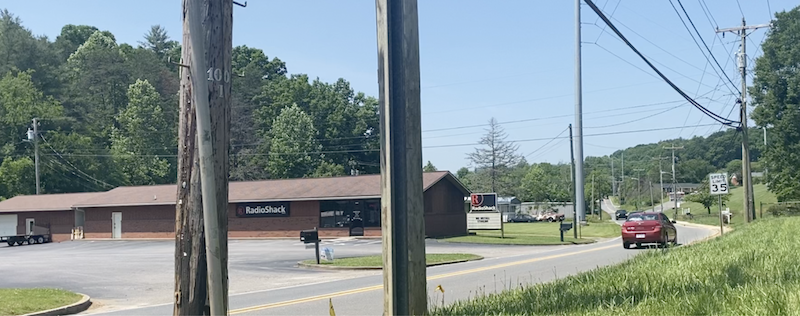
26 Jun 2023
Driving through the Appalachian Mountain area of North Carolina last week I was surprised and shocked to see one of the last RadioShack locations in the USA - a now-defunct retail electronics chain where I purchased my first laptop computer before going to college in 2021.

There are many examples of businesses like RadioShack being slow to turn into the rising tsunami of e-commerce, only to find themselves swamped. Blockbuster Video, Toys R’ Us and JCPenny are all examples of how poor planning and slow adoption of the changing times can crush even the most well-established businesses. These businesses decided to coast on an outdated business model, and were eventually crushed under the weight of their lack of foresight. Their local communities were already ordering inexpensive electronics and toys online, or were streaming NetFlix over renting DVDs - they just didn’t bother to look.
Of the many critical decisions you must make as a self storage developer or owner, nailing down the self storage unit mix is vital to your success. Just as these behemoth enterprises failed to see the customer shift toward e-commerce, cheaper electronics and cheap, fast delivery - self-storage owners and operators need to consider quite a few elements of their local community when deciding what services (aka: storage unit sizes) the local community is demanding.
In our previous article on Self Storage Facility Site Selection | Choosing the Best Storage Location we dissected the motivations and goals of individual self storage facility owners and operators, in an effort to see the gold nugget demographics in even the smallest towns and secondary markets. There are several proven reasons why businesses fail - and it all comes down to planning. As we’ve seen with Toys R’ Us and Blockbuster Video, a lack of agility and willingness to meet the specific needs of the community are the kiss of death for businesses. Of the many catalysts for failure, a self storage facility has a high probability of failure if owners and developers fail to consider critical elements of their chosen area, including;
You might be asking how these elements have any influence at all on self storage unit mix. Let’s dig into it.
First, we need to consider who self storage customers really are to determine what size units they will actually need.
Students - rent units for summer months and typically store the contents of a one bedroom apartment, but may or may not consider the extra cost for climate control debilitating.
Homeowners - typically rent a storage unit when moving, finding HOA restriction work-arounds, and for general storage of furniture and household goods, and typically needing a wide range of storage unit sizes over time as their needs shift.
RV & Boat Owners - typically rent long-term storage due to HOA restrictions in their neighborhood and use their toys based on predictable patterns (i.e. summer months or school holidays).
Businesses - store unused office supplies and furniture, stock, records or product displays, typically needing ground floor or drive up units for easy access to storage materials.
Collectors - rent units to store anything from collector cars to baseball cards and typically care a great deal about the climate and moisture levels within the unit as well as the size and ease of access to their stored items.
You can see that needs and renters vary by area, age, income, occupation and any number of other factors. Each and every area has its own unique market - it’s up to storage owners and operators to do a deep dive into the specific storage unit sizes in demand in their particular area - and to meet that need.
In a recent article published by Inside Self Storage and entitled Maximizing the Design of a Self-Storage Facility researcher and Commercial General Manager Matt Milby with Morton Buildings notes that the typical unit mix he sees with his self storage customers is:
But how did he reach this conclusion? Area demographics will be the most informative tool in your self-storage facility toolbox - but where do you find the demographics data you need to make the decision about your unit mix?
A market study is an analysis of local demand for a product or service, and is typically done by professionals who use surveys, interviews, focus groups and general customer observation to gather information.
These types of businesses typically have detailed records going back years, and are often happy to share data.
Local government offices are responsible for tracking exactly this type of data and will often share it for a small fee.
Software from a reputable company designed to scrape the internet for market data, directed at the needs and interests of the self-storage industry.
Now that you have access to the data you need to make an informed decision, it’s time to break down the data. Cory Sylvester, Principal at Radius+ and DXD Capital has his own unique way of determining optimal unit mix, saying, “We typically figure out an optimal unit mix by both surveying surrounding sites to understand what units managers see as being the most in-demand/out of stock. We also look at pricing analogies to understand what demand there is for each unit type. Finally, we aggregate all of that data to make an informed decision on what unit mix would best suit.” The newest Inside Self Storage White Paper advises looking at three primary elements when deciding final unit breakdown and facility size:
Is your chosen location rural or urban? What is the typical income, education, home size and family size in your area? What about climate or viability or major local employers? Self-storage developers have found that most communities can support 1 storage unit per 100 local residents Choosing to build too small in a large community means leaving money and opportunity on the table and leaving no room for expansion, while building too large in an area with a lower population means unfilled units and lagging business. Check out our article on Common Mistakes made when Building a Self Storage Facility here!
Local competition from other owners or from massive REITS signals danger for your business. If your chosen area already has other self-storage options or upcoming builds, consider shifting to an area without as much competition. Using software like Radius+will give you insight on upcoming self storage projects in your area that you will want to avoid.
Think carefully about what your community needs from a self storage facility. Are you near a University where students will be renting short-term smaller units? Are there lakes, camping or natural tourist attractions in the area, signaling a need for mixed-use RV or boat storage in addition to storage units? Is there crime or unrest in your community, forcing you to consider how much security you can afford to deploy on your site, and therefore influencing the size of your storage facility?
Community needs are just as unique for residents as they are for self-storage owners, operators, investors and managers. It’s critical that you spend time with the numbers that will help you determine the best facility and storage unit sizes to serve your community and make the most of your investment. You wouldn’t throw up a RadioShack or BlockBuster Video in 2023 - so don’t throw caution to the wind when determining how you can supply your local community with what they really need in a storage facility!
For the most up to date self storage data that you will use as your storage unit size guide, check out Radius+, the self storage industry's most comprehensive location intelligence platform for information on everything from self storage supply and demand, to self storage developments, area demographics, and competitor pricing.